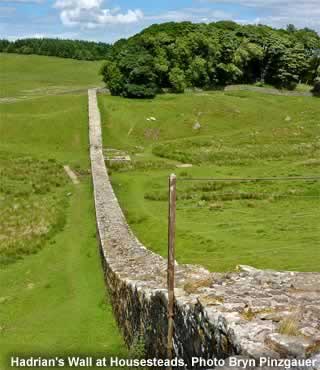Hadrian's Wall |
|
 |
|||
Britain > North England > Hadrian's Wall |
Built by the Romans, now a popular walking route stretching right across the country |
Listen to this article |
Hadrian's Wall is a 73-mile long stone fortification that was built in the second century, by the Roman empire. It stretched across the entirety of mainland Britain, neatly dividing it into "north" and "south". In its day, it was one of the most powerful and imposing symbols of Roman power. |
The reason for its construction was to repel the Scottish. By this time, the Romans had been in England for several hundred years, sailing across the Channel and moving up from the south. But when they tried to extend their territory further by invading the northern end of Britain, they soon ran into problems. The Celtic tribes that lived in the hills were tough, and quick - time and time again, they managed to get the best of the Roman troops, before disappearing like smoke. |
In the year 117AD, Hadrian became Emperor of the empire, and by that time, the Romans had become more focused on defending their territory, rather than expanding it. After a visit to England, Hadrian ordered the construction of a wall, to seal his land off from the "northern barbarians". |
It took six years to complete, but in 128AD, it was finally finished. It measured between two and six metres wide, and in places reached a top height of around five metres. However, it wasn't designed for use as a main defence in a full-scale war. Rather, it was to prevent unauthorised immigration, and to deter groups of raiders or cattle thieves. Still, Hadrian's Wall contained dozens of castles and forts along its route, and was manned by nearly 10,000 men. The Romans continued to occupy the ramparts until their withdrawal, at the turn of the 5th century. |
In the modern day, much of the stonework has been dismantled, broken, or otherwise disappeared. But sections of the wall do still exist, and they remain a popular sight for tourists. There is a path running the entire length of the old barrier, and it is similarly well-used. It provides an insight into ancient history, as well as featuring some of the most celebrated views in England. Sights along the way include Chesters, the best-preserved Roman fort in Britain, and Steel Rigg, considered to be the most beautiful part of the walk. The well-signposted trail also runs directly through the big cities of Carlisle and Newcastle, a stark contrast for walkers from it's mostly rural scenery! |
Both the trail and the remaining parts of the wall are close to many small towns and villages, full of pleasant accommodation and good places to eat. So whether you're a keen walker, or you're interested in the history, or you just want to enjoy all the pleasures of the countryside, then Hadrian's Wall is a perfect and unique place to do it. |
|
Pocket Britain is optimised for use on a smartphone or tablet with internet access. All content is subject to copyright. All reasonable methods have been used to ensure information supplied is accurate at the time of publication. However, it is advisable to check information before relying on it. Privacy Policy |